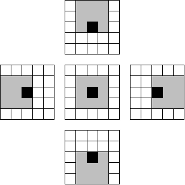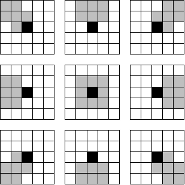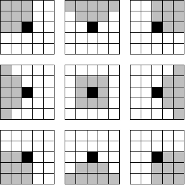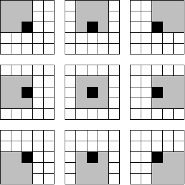NagaoFilter2d
Performs an edge-preserving smoothing of a two-dimensional image by selecting a mean value from different neighborhood configurations.
Access to parameter description
For an introduction to image filters: see Images Filtering.
This algorithm uses an adaptive 5x5 neighborhood geometry to compute a mean neighbors value around a central pixel.
The mean values of different neighborhood configurations around the considered pixel are computed. The pixel is replaced by the mean value of the configuration presenting:
Four neighborhood geometry types are supported by this filter:

Figure 1. The Tsuji-Tomita neighborhoods.

Figure 2. The Nagao 7-pixel neighborhoods.

Figure 3. The Nagao 9-pixel neighborhoods.

Figure 4. The Nagmod neighborhoods.
Reference:
M.Nagao, T.Matsuyama. "Edge preserving smoothing". Computer Graphics and Image Processing, vol. 9, pp. 394-407, 1979.
See also
Access to parameter description
For an introduction to image filters: see Images Filtering.
This algorithm uses an adaptive 5x5 neighborhood geometry to compute a mean neighbors value around a central pixel.
The mean values of different neighborhood configurations around the considered pixel are computed. The pixel is replaced by the mean value of the configuration presenting:
- either the minimum variance,
- or the minimum range (difference between maximum and minimum values)
Four neighborhood geometry types are supported by this filter:
- The Tsuji-Tomita neighborhoods: a set of five 3x3 sub neighborhoods among the 5x5 main neighborhoods.

Figure 1. The Tsuji-Tomita neighborhoods.
- The 7-pixel Nagao neighborhood: a set of nine 7-pixel sub neighborhoods among the 5x5 main neighborhoods.

Figure 2. The Nagao 7-pixel neighborhoods.
- The 9-pixel Nagao neighborhood: a set of nine 9-pixel sub neighborhoods among the 5x5 main neighborhoods.

Figure 3. The Nagao 9-pixel neighborhoods.
- The Nagmod neighborhood: a set of nine 3x3 sub neighborhoods among the 5x5 main neighborhoods.

Figure 4. The Nagmod neighborhoods.
Reference:
M.Nagao, T.Matsuyama. "Edge preserving smoothing". Computer Graphics and Image Processing, vol. 9, pp. 394-407, 1979.
See also
Function Syntax
This function returns outputImage.
// Function prototype
std::shared_ptr< iolink::ImageView > nagaoFilter2d( std::shared_ptr< iolink::ImageView > inputImage, NagaoFilter2d::FilterType filterType, NagaoFilter2d::FilterMethod filterMethod, std::shared_ptr< iolink::ImageView > outputImage = NULL );
This function returns outputImage.
// Function prototype.
nagao_filter_2d( input_image,
filter_type = NagaoFilter2d.FilterType.TSUJI,
filter_method = NagaoFilter2d.FilterMethod.VARIANCE,
output_image = None )
This function returns outputImage.
// Function prototype.
public static IOLink.ImageView
NagaoFilter2d( IOLink.ImageView inputImage,
NagaoFilter2d.FilterType filterType = ImageDev.NagaoFilter2d.FilterType.TSUJI,
NagaoFilter2d.FilterMethod filterMethod = ImageDev.NagaoFilter2d.FilterMethod.VARIANCE,
IOLink.ImageView outputImage = null );
Class Syntax
Parameters
| Class Name | NagaoFilter2d |
|---|
| Parameter Name | Description | Type | Supported Values | Default Value | |||||||||
|---|---|---|---|---|---|---|---|---|---|---|---|---|---|
 |
inputImage |
The input image. | Image | Binary, Label, Grayscale or Multispectral | nullptr | ||||||||
 |
filterType |
The neighborhood geometry type.
|
Enumeration | TSUJI | |||||||||
 |
filterMethod |
The neighborhood selection criterion.
|
Enumeration | VARIANCE | |||||||||
 |
outputImage |
The output image. Its dimensions, type, and calibration are forced to the same values as the input. | Image | nullptr | |||||||||
Object Examples
std::shared_ptr< iolink::ImageView > polystyrene = ioformat::readImage( std::string( IMAGEDEVDATA_IMAGES_FOLDER ) + "polystyrene.tif" ); NagaoFilter2d nagaoFilter2dAlgo; nagaoFilter2dAlgo.setInputImage( polystyrene ); nagaoFilter2dAlgo.setFilterType( NagaoFilter2d::FilterType::TSUJI ); nagaoFilter2dAlgo.setFilterMethod( NagaoFilter2d::FilterMethod::VARIANCE ); nagaoFilter2dAlgo.execute(); std::cout << "outputImage:" << nagaoFilter2dAlgo.outputImage()->toString();
polystyrene = ioformat.read_image(imagedev_data.get_image_path("polystyrene.tif"))
nagao_filter_2d_algo = imagedev.NagaoFilter2d()
nagao_filter_2d_algo.input_image = polystyrene
nagao_filter_2d_algo.filter_type = imagedev.NagaoFilter2d.TSUJI
nagao_filter_2d_algo.filter_method = imagedev.NagaoFilter2d.VARIANCE
nagao_filter_2d_algo.execute()
print( "output_image:", str( nagao_filter_2d_algo.output_image ) )
ImageView polystyrene = ViewIO.ReadImage( @"Data/images/polystyrene.tif" );
NagaoFilter2d nagaoFilter2dAlgo = new NagaoFilter2d
{
inputImage = polystyrene,
filterType = NagaoFilter2d.FilterType.TSUJI,
filterMethod = NagaoFilter2d.FilterMethod.VARIANCE
};
nagaoFilter2dAlgo.Execute();
Console.WriteLine( "outputImage:" + nagaoFilter2dAlgo.outputImage.ToString() );
Function Examples
std::shared_ptr< iolink::ImageView > polystyrene = ioformat::readImage( std::string( IMAGEDEVDATA_IMAGES_FOLDER ) + "polystyrene.tif" ); auto result = nagaoFilter2d( polystyrene, NagaoFilter2d::FilterType::TSUJI, NagaoFilter2d::FilterMethod::VARIANCE ); std::cout << "outputImage:" << result->toString();
polystyrene = ioformat.read_image(imagedev_data.get_image_path("polystyrene.tif"))
result = imagedev.nagao_filter_2d( polystyrene, imagedev.NagaoFilter2d.TSUJI, imagedev.NagaoFilter2d.VARIANCE )
print( "output_image:", str( result ) )
ImageView polystyrene = ViewIO.ReadImage( @"Data/images/polystyrene.tif" ); IOLink.ImageView result = Processing.NagaoFilter2d( polystyrene, NagaoFilter2d.FilterType.TSUJI, NagaoFilter2d.FilterMethod.VARIANCE ); Console.WriteLine( "outputImage:" + result.ToString() );